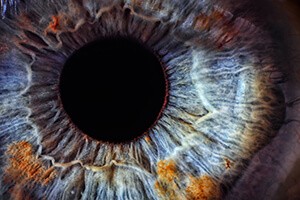The Physiology of Your Eyes
 Your eyes are the windows to the world. They allow you to see and interpret the shapes, colors, and dimensions of objects by processing the light they reflect. Like a camera, your eyes use light to form images. In a camera, light passes through a lens back onto the film. The cornea (outer layer of your eye) and lens inside your eye are similar to a camera’s lens system. Your pupil, located at the center of the iris (colored portion of the eye) acts like the shutter of a camera to control the amount of light that enters. The retina is located at the back of your eye and is similar to the camera’s film. In the normal eye, light rays pass through the cornea and lens and are focused directly on the retina to produce a clear image. The retina then sends the image to the brain. The eye’s complex optical components receive, focus, and process light into nerve impulses, which are sent to the brain – that is how we “see.”
Your eyes are the windows to the world. They allow you to see and interpret the shapes, colors, and dimensions of objects by processing the light they reflect. Like a camera, your eyes use light to form images. In a camera, light passes through a lens back onto the film. The cornea (outer layer of your eye) and lens inside your eye are similar to a camera’s lens system. Your pupil, located at the center of the iris (colored portion of the eye) acts like the shutter of a camera to control the amount of light that enters. The retina is located at the back of your eye and is similar to the camera’s film. In the normal eye, light rays pass through the cornea and lens and are focused directly on the retina to produce a clear image. The retina then sends the image to the brain. The eye’s complex optical components receive, focus, and process light into nerve impulses, which are sent to the brain – that is how we “see.”
Refractive Errors
The most common vision problem is the eye’s inability to focus incoming light onto the retina, causing blurred vision. This is caused by the way your eye refracts or bends light and focuses the light rays. The shape of the cornea, the power of the lens inside the eye, and the length of the eye together determine how rays of light are focused on the retina, the membrane that lines the back wall of the eye. These three components must be well matched for the eye to see clearly without correction. If the cornea is too steeply curved, then nearsightedness results. If the cornea is too flat, then farsightedness results. When the cornea has a shape similar to a football astigmatism results.
For the vision of your dreams, make a clear choice: Tylock-George Eye Care & Laser Center. Please call or email us for a LASIK evaluation or attend our complimentary LASIK Seminar held on Tuesdays at 6:00pm at our office. If you would like more information on IntraLASIK or LASIK vision correction in general, please fill out a short form and we will get you this information as soon as possible.
Contact one of our patient directors in the Dallas, Fort Worth area today to schedule a complete eye examination.













